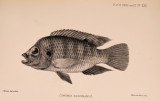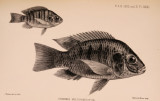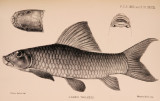| OCR Text |
Show 280 MR. R. SHELFORD OX MIMETIC INSECTS AXD [Nov. 4, large irregular punctures, and marked on each side with a longitudinal line of rounded white scales, and in the middle with aline of small scales; moreover, punctiform scales are sunk in the punctures. The elytra are slightly broader at the base than the prothorax in the middle, the sides are parallel, the apex is normally narrowed; they have above three narrow longitudinal costae, the interstices between which are punctate and provided with rounded scales; the sides are foveate, each fovea shows a setiform scale ; moreover, a line of rounded scales is present along the lateral margin; the outer angles of the elytra at the apex are simply toothed. The metasternum and the base of the abdomen are covered with rounded scales; the rostrum beneath and the legs are scattered with scale-like setae. The 3rd abdominal segment is short and contracted in the middle. § . Agrees with the male in all respects except the following :-The body is broader ; the head short, nearly square ; the metarostrum is shorter, as long as the head ; the prorostrum much more elongate, longer tha.n the metarostrum ; the antennae are inserted between the middle of the rostrum and its base ; they are comparatively shorter and stouter; the 3rd abdominal segment is longer and not contracted. Length 17-23 mm. Hub. Kuching (N. W. Borneo). Allied to D. furcillatus (Gylh.), but the new species has the head shorter and the eyes more prominent; the prorostrum is shorter; the joints of the antennae are longer, the three apical ones more distinct; the apex of the elytra are broader and slightly toothed ; the body is shorter and stouter. The female of the new species is, moreover, distinguished by the metarostrum which is shorter, and by the antennae which are inserted before the middle of the rostrum. I have named this species in honour of Mr. R. Shelford, who has kindly presented an interesting collection of Bornean Brentliids to the Oxford University Museum. D iu r u s s i l v a x u s Senna, (Plate X X . fig. 4, $ .) The female of this species being hitherto undescribed, I give a short description of i t :- The head is nearly square, with a fovea, between the eyes; the metarostrum is short, hardly so long as the head, channelled above, and slightly narrowed before the antennae ; the prorostrum is slender, glossy, finely punctured, as long as the head and metarostrum taken together. The antennae, which are consequently more approximate to the base than to the apex of the rostrum, are rather stout, with the 3rd joint longer than the 4th, the 6th and 7th subequal, the 8th a little shorter, the three apical joints well distinct and separate. The prothorax is strongly contracted anteriorly, the sides towards the middle are almost |
































































































































































































































































































































